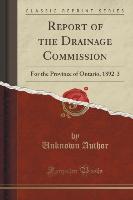- Start
- Report of the Drainage Commission
Report of the Drainage Commission
Angebote / Angebote:
Excerpt from Report of the Drainage Commission: For the Province of Ontario, 1892-3
At the portals of this enquiry, we find rivers forming the great natural highways for water, from the interior of the Province to the lakes and bays lying to the north-west and south of it. These rivers, with their branches, are the result of the natural formation of the country, and afford the main channels for conveying away to an outlet water produced by rain, ice and snow, and also that which comes from springs and other subterraneous supplies.
Woolrych defines a river as a running stream, pent in on either side with walls and banks, and it bears that name as well where waters flow and reflow, as where they have their current one way.
This definition has been held to include all natural streams however small, and which have a definite and permanent course, and to exclude all bodies of water which are of a temporary character, that is to say, those dependent on the will or convenience of individuals for their volume or duration.
Curtis, J., in a case of Howard vs. Ingersoll tried in the United States, says: "The banks of a river are those elevations of land which confine the waters when they rise out of the bed, and the bed is that soil so usually covered with water as to be distinguishable from the banks by the character of the soil or vegetation, or both, produced by the common presence and action of flowing water, but neither the line of ordinary high-water mark, nor of ordinary low-water mark, nor of a middle stage of the water, can be assumed as the line dividing the bed from the banks. The line is to be found by examining the bed and the banks and ascertaining where the presence and action of water are so common and usual, and so long confined in ordinary years, as to mark upon the soil of the bed a character distinct from that of the banks in vegetation as well as in respect to the nature of the soil itself, whether this line between the bed and the banks will be found above, or below, or at the middle stage of the water, must depend on the character of the stream. The height of a stream during much the larger part of the year may be above or below a middle point between its highest and least flow. Something must depend also on the rapidity of the stream and other circumstances. But in all cases the bed of a river is the natural object and is to be sought for, not merely by the application of any abstract rules, but as other natural objects are sought for and found, by the distinctive appearances they present, the banks being fast land, on which vegetation appropriate to such land in the particular locality grows, wherever the bank is not too steep to permit such growth, and the bed being soil of a different character and having no vegetation, or only such as exists when commonly submerged in water."
The owner of lands on the bank of a river is prima facie the owner of half the bed of the river. Coulson & Forbes on waters, at page 93, state the law as follows: "When the lands of two conterminious properietors are separated from each other by a running, non-tidal stream of water, each proprietor is prima facie owner of the soil of the alveus or bed of the river to the middle thread of the stream.
About the Publisher
Forgotten Books publishes hundreds of thousands of rare and classic books. Find more at www.forgottenbooks.com
Folgt in ca. 5 Arbeitstagen
